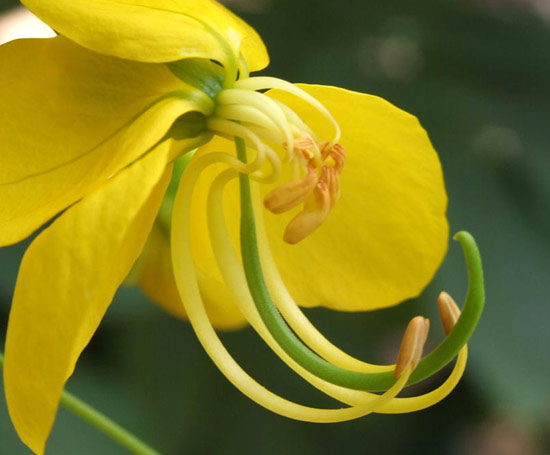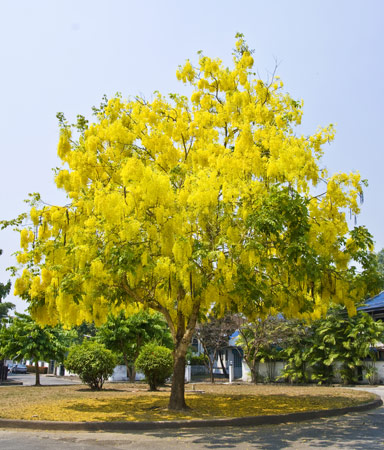National Symbols: National Flower
Ratchaphruek (common name)
Cassia fistula (scientific name)
Designation
Official
Also Known As
Golden shower tree, golden shower cassia, purging cassia, Indian laburnum, drumstick tree, dok khuen
Classification
- Kingdom: Plantae
- Division: Magnoliophyta
- Class: Eudicots
- Order: Fabales
- Family: Fabaceae
- Genus: Cassia
- Species: C. fistula
The Flower
When in bloom, the ratchaphruek tree displays hanging clusters of very bright yellow flowers, accounting for its great popularity as an ornamental plant. Each flower has five oval petals. Three are relatively short and round, and sit opposite two narrower, longer petals. There are ten stamens in the center of each bloom, three of which are longer than the others. The flowers are subtly fragrant, and attract butterflies and bees, which act as pollinators. The tree loses its leaves when blooming, emphasizing the beauty of the flowers. After flowering, the tree grows cylinder-shaped pods about 20-60 cm (8-23.5 in) long and 1.5-2.5 cm (.5-1 in) wide, each containing between 25 and 100 shiny, lentil-shaped seeds. The trunk is straight and capped with a canopy of spreading branches. On young trees, the bark is smooth and light gray, changing to a rough texture and dark brown color as the tree ages. The leaves are evenly pinnate, without a terminal leaflet.
Physical Details
Duration: Perennial
Plant: A fast-growing moderate-sized deciduous tree
Mature Height: 10-20 m (33–66 ft)
Flowering: February-May
Flowers: 5-8 cm (2-3 in) wide five-petaled flowers blooming along hanging stems 20-45 cm (8-18 in) long.
Flower Color: Bright yellow
Leaves: 30-40 cm (12-16 in) long pinnate leaves with four to eight pairs of pointed oval leaflets, each 4-15 cm (1.5-6 in) long.
Fruit / Seed Color: Brown.
Habitat
Location: Tropical and subtropical regions with full sun and well-drained soil.
Range: Southern Asia, from southern Pakistan through India, south to Sri Lanka, and east into Myanmar and Thailand.
Trivia
- Ratchaphruek has been an official emblem of Thailand since 2001. The tree is also known as chaiyaphruek in Thai, which means "tree of triumph." The flowers' bright yellow color is considered extremely auspicious; it's associated with Buddhism, the Thai king, nobility and glory. It's usual for all ratchaphruek trees to bloom at about the same time, which is seen as a botanical metaphor for the unity of the Thai people.
- Parts of the plant are used in traditional medicine: for example, the pith in mature pods is used as a laxative, a treatment for arthritis and heart disease, and as a coagulant to stanch bleeding. The seeds are poisonous.
- The wood is strong and attractive, and is used in furniture production.
Article written for World Trade Press by WTP Staff.
Copyright © 1993—2025 World Trade Press. All rights reserved.

 Thailand
Thailand 
